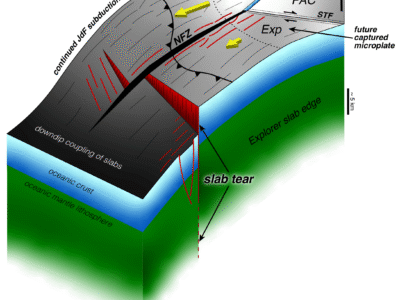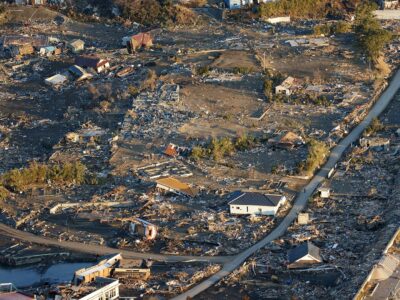
When a magnitude 4.8 earthquake struck northern New Jersey’s Tewksbury township on April 5, it triggered widespread alarm. Small tremors occur sporadically in the region, but this was the biggest since 1884, when a quake of approximately magnitude 5 struck under the seabed off Brooklyn, cracking walls and toppling chimneys.
Based on existing models, the earthquake should have done substantial damage at its epicenter, but that didn’t happen. Meanwhile, relatively distant New York City shook much harder than expected, causing damage, albeit minor. Outsize shaking extended all the way to Virginia and Maine. A new study suggests why, calling into question some assumptions about regional earthquake hazard.
“There was some peculiar behavior,” said study coauthor Won-Young Kim of the Columbia Climate School’s Lamont-Doherty Earth Observatory
While 4.8 is not a major quake in global terms, people in the populous U.S. Northeast are not used to anything that big. The U.S. Geological Survey (USGS) estimates it was felt by some 42 million people; a USGS online portal that crowd-sources first-person reports of shaking received nearly 184,000 entries―the most ever from any U.S. quake, according to a companion paper about the event. Both papers just appeared in the journal The Seismic Record.

Hours after the quake, Kim and colleagues headed to the epicenter to survey the situation. “We expected some property damage―chimneys knocked down, walls cracked or plaster fallen, but there were no obvious signs,” said Kim. “We talked to police officers, but they were not very excited about it. Like nothing happened. It was a surprising response for a magnitude 4.8 earthquake.”
Separate from the size of an earthquake itself, the surface motion it generates is measured on the Modified Mercalli Intensity Scale. Based on the magnitude, the quake’s depth (a fairly shallow 5 kilometers, or 2.9 miles) and area geology, existing models posit that a 10-kilometer area around the epicenter should have seen intensity VII shaking on this scale, described as “very strong.” Most well designed and built structures would probably get off without much damage, but others of lesser design or materials could collapse, especially unreinforced masonry walls and chimneys.
However, no one at or around the epicenter reported intensity VII shaking or anything close to it. Damage was limited to minor cracking in some dry wall and a few items knocked off shelves. The only exception: an already crumbling grist mill built in the 1760s of unreinforced stone, and already largely a wreck. About 3.5 miles from the epicenter, part of the mill’s facade toppled.

Usually, shaking fades out in a more or less symmetrical bull’s eye pattern from the source. But that did not happen either; stronger than expected shaking extended far out, mainly to the northeast, and to a lesser extent other directions.
In Newark, N.J, some 20 miles from the epicenter, three row houses were partly toppled. Residents of New York City, some 50 miles away, reported intensity IV motion, with sustained vibrations of windows, doors and walls. More than 150 buildings reported minor damage, mainly superficial cracks in masonry. However, inspectors ordered two Bronx buildings to erect protective sidewalk sheds when cracks appeared in their facades, and a Brooklyn public school had to close part of the building because of vertical step-shaped cracks along an interior wall. Gas and water lines developed leaks as far off as the lower Hudson Valley, and on Long Island, the front of someone’s Jeep slumped into a suddenly opened sinkhole. Even people in parts of New Hampshire, some 280 miles away, reported intensity III shaking, similar to a big truck passing by.
To understand what happened, Kim and colleagues at South Korea’s Seoul National University analyzed so-called Lg waves. These are a type of low-frequency wave of energy that bounces back and forth between the Earth’s surface and the Moho―the boundary between the Earth’s crust and the mantle, which in this area lies about 35 kilometers down. The analysis suggested that the quake took place on a previously unmapped fault that runs south to north. The fault is not vertical, but rather dips eastward into the Earth at about a 45-degree angle.
According to the analysis, the movement was rapid and complex―a circular combination of the two sides of the fault sliding horizontally against each other (known as strike-slip motion) and one side also shoving itself up and over the other (known as a thrust). Once the rupture started, it spread horizontally to the north. Usually much of the energy from such a quake takes the path of least resistance―that is, straight up to the surface, where pressure on the rock is the least.

That was not the case here, the researchers say. Instead, much of the energy headed downward, along the fault’s dip, and continued until it hit the Moho. Then it bounced back up, emerging among other places under New York City, which was right in the way. Then the wave bounced back down and re-emerged further away in New England, somewhat weaker, and so on, until it petered out. The long-distance echoes were likely strengthened by the fact that most rocks underlying this region are hard and dense, and conduct energy efficiently, like the ringing of a bell.
The area from Philadelphia to southwestern Connecticut has seen some 500 known quakes from the 1600s to the present, but many others almost certainly went unnoted before modern seismic instruments came along. Most are so faint, few if any people feel them, and the vast majority of the others have been harmless. But the threat could be greater than previously thought, according to an earlier paper led by Lamont-Doherty seismologist Lynn Sykes.

These quakes are not caused by ongoing movements of giant tectonic plates like those in much more hazardous places like California. Rather, they emanate from ancient fault zones dating as far back as 200 million years, when what is now Europe tore away from what is now North America, causing massive quakes that cracked up the subsurface. Some of these crumbly zones are still settling and readjusting themselves, and occasionally parts of them move with a jolt.
Based on the short historical record, quakes the size of April’s or slightly larger come along roughly every 100 years. But based on the sizes of known faults and other calculations, Lamont seismologists have suggested that the area could see a magnitude 6 every 700 years, and a magnitude 7 every 3,400 years. The magnitude scale is exponential, so a magnitude 6 is 10 times more powerful than a 5, while a magnitude 7 is 100 times more powerful than a 5. No one knows if such quakes have occurred in human time or could, but if one did, it would be catastrophic.

The April 5 quake has brought about a spurt of new research. In cooperation with the USGS and other researchers, Kim helped place a temporary network of dozens of seismometers near the epicenter to monitor aftershocks, which continued for weeks. These signals are being used to better map various details of the quake, and the area’s faults.
Lamont-Doherty structural geologist Folarin Kolawole and colleagues have been mapping numerous bedrock fractures near the epicenter caused by past earthquakes of indeterminate ages. These could well be millions of years old, says Kolawole, but they could also point to current, unmapped zones of weakness lurking below.
Meanwhile, Lamont-Doherty geologist William Menke is working to document possible prehistoric quakes in the more recent past. New York’s Harriman State Park, just over the border from New Jersey, is littered with giant boulders dropped onto the surface when glaciers from the last ice age melted, some 15,000 to 20,000 years ago. Many are precariously balanced in their original positions. Menke’s hypothesis: if he can calculate the earthquake force that would be required to tip the boulders over, he can rule out an earthquake of that size, at least for that time period.
Kim said that the new study suggests the need to re-evaluate how shaking from any future quake may travel across the region. “Some that are not even that big could maybe focus energy toward population centers. If [the April] earthquake was just a little stronger, or a little closer to New York City, the effect would be much greater,” he said. “We need to understand this phenomenon and its implications for ground motion prediction.”
The study’s lead author is YoungHee Kim; the other coauthors are Sangwoo Han, Jun Yong Park and Min-Seong Seo, all of Seoul National University.



